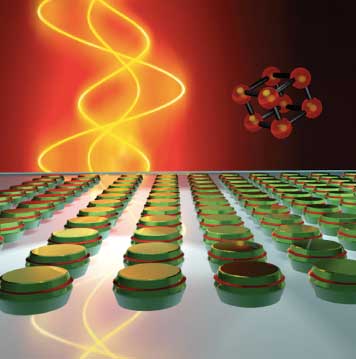| May 20, 2020 | |
Researchers develop material capable of being invisible or reflective in IR spectrum(Nanowerk News) Modern optical devices require constant tuning of their light interaction settings. For that purpose, there exist various mechanical apparatuses that shift lenses, rotate reflectors, and move emitters. |
|
| An international research team that includes staff members of ITMO University and the University of Exeter have proposed a new metamaterial capable of changing its optical properties without any mechanical input. This development could result in a significant improvement in the reliability of complex optical devices while making them cheaper to manufacture. | |
| The study was featured on the cover of Optica ("Reconfigurable multilevel control of hybrid all-dielectric phase-change metasurfaces"). | |

|
|
| The rapid development of physics and materials science in the past decades has brought humanity a wide selection of materials. Now, those who design complex devices are less bound by the limitations of traditional materials such as metals, wood, glass, or minerals. | |
| In this regard, the so-called metamaterials, which are studied at ITMO University among other places, open up incredible opportunities. Thanks to their complex periodical structure, they are relatively independent from the properties of their components. Such structures can be volumetric or flat – in the latter case, they are referred to as metasurfaces. | |
| “Metasurfaces allow us to achieve many interesting effects in the manipulation of light,” says Ivan Sinev, a senior researcher at ITMO University’s Faculty of Physics and Engineering. “But these metasurfaces have one issue: how they interact with light is decided right in the moment when we design their structure. When creating devices for practical use, we would like to be able to control these properties not only at the outset, but during use, as well.” | |
| In their search for materials for adaptive optical devices, researchers from ITMO University, who possess great experience in working with silicon metasurfaces, have joined forces with their colleagues from the University of Exeter in the UK, who have a lot of experience in working with phase-change materials. Among such materials is, for instance, the germanium antimony telluride (GeSbTe) compound, often used in DVDs. | |
| “We’ve made calculations to see what this new composite material would look like,” says Pavel Trofimov, a PhD student at the Faculty of Physics and Engineering. “We have an inclusion of GeSbTe embedded as a thin layer between two layers of silicon. It’s a sort of sandwich: first we coat a blank substrate with silicon, then put on a layer of phase-change material, and then some more silicon.” | |
| Then, using the methods of e-beam lithography, the scientists converted the layered structure into a metasurface: an array of microscopic disks that was then tested at the laboratory on the subject of its ability to manipulate light. As the researchers expected, the combination of two materials into a complex periodic structure resulted in an important effect: the resulting surface’s transparency level could be changed throughout the experiment. | |
| The reason is that a silicon disk in the near-infrared region has two optical resonances, allowing it to strongly reflect IR beams directed onto its surface. The layer of GeSbTe has made it possible to “switch off” one of the two resonances, making the disk nearly transparent to light in the near-infrared region. | |
| Phase-change materials have two states: a crystalline state in which its molecules are positioned in an ordered structure, and an amorphous state. If the layer of GeSbTe at the center of the metamaterial is in the crystalline state, the second resonance will disappear; if it is in the amorphous state, the disk will continue to reflect IR beams. | |
| “To switch between the two metasurface states, we’ve used a sufficiently powerful pulse laser,” explains Pavel Trofimov. “By focusing the laser on our disk, we’re able to perform the switch relatively quickly. A short laser pulse heats up the GeSbTe layer nearly to the melting point, after which it quickly cools down and becomes amorphous. If we subject it to a series of short pulses, it cools down more slowly, settling into a crystalline state.” | |
| The properties of this new metasurface can be used for various applications. That includes, first and foremost, the creation of lidars – devices that scan spaces by emitting infrared pulses and receiving the reflected beams. The principle of their creation can also serve as the basis in the production of special ultra-thin photographic lenses, such as ones used in phone cameras. |
| Source: ITMO University | |
|
Subscribe to a free copy of one of our daily Nanowerk Newsletter Email Digests with a compilation of all of the day's news. |
